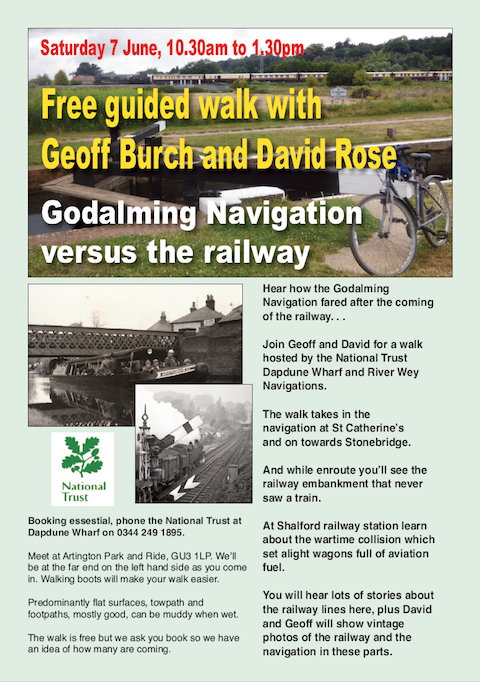 Abraham Lincoln
If given the truth, the people can be depended upon to meet any national crisis...
Abraham Lincoln
If given the truth, the people can be depended upon to meet any national crisis...
 Guildford news...
for Guildford people, brought to you by Guildford reporters - Guildford's own news service
Guildford news...
for Guildford people, brought to you by Guildford reporters - Guildford's own news service
Council Proposes To Delay Planning Application For Phase II Of Clay Lane Link Road
Published on: 7 Feb, 2016
Updated on: 7 Feb, 2016
Despite Guildford Borough Council’s (GBC) committed to providing a second access to the Slyfield Industrial Estate to relieve congestion on the A320, it is expected to delay a planning application for the second phase of the project.
It follows the council having listened to local residents’ concerns over the project, known as the Clay Lane Link Road (CLLR).
The council has annouced that at its meeting on February 23 the Executive will be asked by Cllr Matt Furniss, lead councillor for infrastructure and environment, to delay the application until Highway England’s plans for the upgrading of the A3 are clearer, and to take a decision to submit a planning application for the first phase only.
The first phase of the CLLR is the road infrastructure within the Slyfield Industrial Estate (SIE) to support the Slyfield Area Regeneration Project (SARP) and the second is the actual link road from Slyfield to Clay Lane in Jacobs Well.
In a council statement, Cllr Furniss said: “We have listened to residents’ concerns and will take more time before submitting a planning application for the road between Slyfield and Clay Lane, which is phase two of the CLLR scheme. According to current Highways Agency timescales, the information we need about their A3 upgrade plans is expected to be available in approximately 18 months.
“In the meantime we will continue work on how the first phase of the scheme can support the regeneration of the Slyfield area, including a new waste transfer station and relocating the existing sewage works and the council depot to help provide much-needed homes on this important brown field site.”
Jacobs Well resident Steve Knight, who is a Worplesdon parish councillor and a member of a number of local groups has responded to the news. He wishes it to be known at this stage that these are his personal comments and not as the official spokesman of the Jacobs Well Residents’ Association, Burpham Community Association, or the Clay Lane Action Group.
He said: “The Jacobs Well Residents Association (JWRA) and Burpham Community Association (BCA), (representing the residents of Jacobs Well and Burpham), and I are obviously pleased that Cllr Furniss and his Clay Lane Link Road team appear to have at last listened to the views/concerns of the residents and decided to delay work on any new road across the flood plain to Clay Lane for at least 18 months until the full Highways England (HE) plans are known.
“Personally I feel it was just a shame that we had to put in so much time and effort and write letters, run a petition (and subsequently go to scrutiny), put up banners and raise awareness with other residents’ associations, before they took notice.
“We had to do this because no-one from the GBC CLLR team seemed to appreciate any of the residents’ concerns during the three consultation stages that occurred – to residents it felt like we were trying to stop a driver-less juggernaut.
“Although improved traffic flow in and out of Slyfield Industrial Estate (SIE) may be needed, including a second access, I feel that a very costly new road across the main north Guildford flood plain from SIE to Clay Lane remains unproven or cost justified.
“In the petition all that was being asked was that the GBC CLLR team delay submitting a planning application until all the HE plans were known – it was not stating that there had to be another exit off of the A3 into SIE (although this does seem the obvious solution). It now appears that the CLLR team agree with the petition motion.
“Although there has been a press release highlighting the 18-month delay in any road building, I would like this confirmed and minuted at the full GBC council meeting on Wednesday, February 10, so that everyone is clear.
“I would like it confirmed that the first phase relates to road infrastructure work within SIE and that the second phase relates to any road building from SIE to Clay Lane, across the flood plain and green belt land. This is because originally, if my memory serves me right, phase I and II meant something different.
“Going forward, over the next 18 months, hopefully the local residents (who have now formed the Clay Lane Action Group (CLAG)) and gained support from other local resident bodies) can now work closer with the GBC CLLR team to ensure all relevant issues/aspects and costs/benefits are discussed openly and professionally and there are no hidden agendas (e.g. whether the proposed CLLR is for the benefit of SIE regeneration, the proposed 1,057 new homes planned to be built on the old Woking Road depot site, or both). Releasing the AECOM environmental report, which was promised early December, would be a good place to start.
“In summary, I suppose myself and the vast majority of residents in Jacobs Well, Burpham and Sutton Green are relieved but appreciate that although a major battle may have been won, the war goes on! Hopefully the next 18 months will not have too many casualties.”
Burpham resident Jim Allen, an opponent of the CCLR, and who has regularly made his views known about it, said: “I understand that common sense has prevailed on the subject of ‘first things first’.
“I am sure the communities affected, appreciate our councillors are listening to our genuine concerns and hope they continue listening, way into the distant future.
“I guess we all look forward to a positive reaction by the council Executive to Cllr Furniss’ presentation / request that the link road application is delayed.
“The implied delay of 18 months will allow time for council officers and elected councillors to reflect on the quality of ideas and digest the data currently being used to plan our communities’ strategic future.”
Responses to Council Proposes To Delay Planning Application For Phase II Of Clay Lane Link Road
Leave a Comment Cancel reply
Please see our comments policy. All comments are moderated and may take time to appear. Full names, or at least initial and surname, must be given.Recent Articles
- Letter: I Would Rather Have Potholes Filled
- New Parish Councillor Says Funds from Developers Must Benefit the Local Community
- Tests at Paddling Pool Showed Water Was Too Alkaline, Says GBC
- Letter: Our Residents Want CIL Money Properly Used for Infrastructure Without Delay
- Charity’s New Programme Meets Needs of SEND Children Without School Places
- Pasta Evangelists to Open First Restaurant Outside London – Right Here in Guildford
- Police Seek Witnesses to Park Barn Assault
- Notice: Rosamund Community Garden
- Village School Set to Close Due to Falling Birth Rate
- Letter: Waverley’s Management of CIL Money Is Morally Questionable


Recent Comments
- Warren Gill on Millions of Taxpayer Money Recovered from Railway Fare Dodgers
- Roshan Bailey on Public Asked for Views on SCC’s Proposal for Reduced Speed Limits
- R Wong on Letter: Our Residents Want CIL Money Properly Used for Infrastructure Without Delay
- Nigel Keane on Village School Set to Close Due to Falling Birth Rate
- Patrick Bray on Public Asked for Views on SCC’s Proposal for Reduced Speed Limits
- Mark Percival on Public Asked for Views on SCC’s Proposal for Reduced Speed Limits
Search in Site
Media Gallery
Dragon Interview: Local Artist Leaves Her Mark At One of England’s Most Historic Buildings
January 21, 2023 / No Comment / Read MoreDragon Interview: Lib Dem Planning Chair: ‘Current Policy Doesn’t Work for Local People’
January 19, 2023 / No Comment / Read MoreA3 Tunnel in Guildford ‘Necessary’ for New Homes, Says Guildford’s MP
January 10, 2023 / No Comment / Read More‘Madness’ for London Road Scheme to Go Ahead Against ‘Huge Opposition’, Says SCC Leader
January 6, 2023 / No Comment / Read MoreCouncillor’s Son Starts Campaign for More Consultation on North Street Plan
December 30, 2022 / No Comment / Read MoreCounty Council Climbs Down Over London Road Works – Further ‘Engagement’ Period Announced
December 14, 2022 / No Comment / Read MoreDragon Interview: GBC Reaction to the Government’s Expected Decision to Relax Housing Targets
December 7, 2022 / No Comment / Read MoreHow Can Our Town Centre Businesses Recover? Watch the Shop Front Debate
May 18, 2020 / No Comment / Read More

















Bibhas Neogi
February 8, 2016 at 2:20 pm
I am pleased to see that the council would wait for the Highways England’s proposals for the A3 before deciding on the Phase II of the project.
I commented back on October 29 here in these columns:
“An excellent letter by Mr Frank Phillipson on the issues concerning CLLR.
I would reiterate that a direct Slyfield link with the A3 would be a much better option to go for and it would obviate the traffic issues on existing Clay Lane and help improve the A3 junctions as well. I would draw attention to my comments last month here on the Dragon News:-
https://guildford-dragon.com/2015/09/27/have-your-say-on-proposed-clay-lane-link-road/#comments
“Moorfield Road junction with the A320 of course needs to be improved and parking on this road as clearly shown in the picture must be made off-road and speed reduction measures would enhance safety.
Considering the SARP and the possibility of 1,000 new homes, further analyses of CLLR by taking all these factors into account are warranted.
“It would be premature to proceed with this scheme without considering Highways England’s A3 improvement scheme that is currently being developed by them.”
Liz Critchfield
February 9, 2016 at 1:31 pm
I am writing on behalf of the Burpham Community Association (BCA).
For some two years the BCA has argued against the CLLR, so Vllr Furniss’s statement is most welcome.
It is heartening to know that the views of local people have been taken into account and we hope that this enlightened attitude will continue.
The BCA, along with Jacobs Well Residents’ Association and Sutton Green Association, is part of the Clay Lane Action Group.
We now look to GBC to work together with residents to develop a more holistic approach to local road infrastructure, including any A3 proposals, as the piecemeal approach that has prevailed to date has led to the present chaos.
Let us hope that all interested parties make good use of the next 18 months and work together with honesty, common sense and integrity.
Liz Critchfield is the secretary of the Burpham Community Association
Bibhas Neogi
February 13, 2016 at 9:17 am
Steve Knight, who is a Worplesdon parish councillor and a member of a number of local groups has said: “In the petition all that was being asked was that the GBC CLLR team delay submitting a planning application until all the HE plans were known – it was not stating that there had to be another exit off of the A3 into SIE (although this does seem the obvious solution). It now appears that the CLLR team agree with the petition motion.”
Well, why not campaign for a direct link to the A3 and influence the way Highways England are developing the A3 widening and junction improvement works?
I have proposed a layout for such a junction and suggested how merge/diverge conflicts of slip roads could be avoided due to proximity of adjacent junctions both for a Slyfield junction and another one for Gosden Hill, if proposed housing schemes go ahead.
Please see the sketch in the link below:
http://tinyurl.com/New-A3-junctions
Jim Allen
February 14, 2016 at 10:03 am
With great respect to Mr Neogi, there are several questions which need to be answered before the question of any need for a second road to be built.
1: where does the traffic come from and go to? Currently unknown.
2: Is the volume of traffic using Slyfield a justification of a ‘new’ road or simply improvement of the existing road?
The answer to (1) may be found in the 1990s survey which stated 75% of commercial traffic using Surrey roads travel less than nine miles and 50% travel less than five miles.
None of the 75% can use the A3 because you can’t get anywhere within nine miles on the A3
The answer to (2) could be found by the sum – 104 companies each employing on average say 10 staff say 1,000 people [the 2,000 jobs ‘on’ Slyfield seems inaccurate] So, 1,000 cars over eight hours plus occasional visitors / deliveries say another 1,000 so 2,000 vehicles over 10 hours.
Clay Lane has, on average, 1,500 vehicles per hour – the number of vehicles using Slyfield (claimed 750 – majority observed – single occupancy vehicles entering between 7am and 9amm, if I remember correctly) suggests – there is no financial justification now or in the future to spend in excess of £10 million to dam an active flood plain when say half of that money spent on improving current infrastructure would solve the problem.
Finally, access to the A3 from the A320 – in 1970s The ‘Roads Appeal Inspector’ stated there is a known need for a four-way intersection at the A320 “as proposed by GBC”, this should be re-applied for when the Bellfields section of the A320 is completed (as it is now).
Perhaps the first action of GBC improving traffic in the area is to re-apply for that junction to be made four way – which would fundamentally improve all the roads in the area as it will lift off traffic from Ladymead and the majority of all south-west bound traffic from the north end of Guildford.
Bibhas Neogi
February 15, 2016 at 8:38 am
If a direct link to Slyfield from the A3 is explored, Highways England (HE) will no doubt do all the traffic analyses and the pros and cons of such a link. The HE would only go ahead if the answers are favourable.
I would see such a link as providing a shorter route between the A320 and the A3 for northbound traffic and their return. This would relieve Clay Lane traffic a great deal.
Building a road over a flood plain is nothing new. It does not mean damming up when it is designed to allow more than adequate flow under it during flooding conditions.
Jim Allen
February 16, 2016 at 3:53 pm
The choiuce is: know where the traffic goes to before deciding and avoid the flood plain when other options exits.
Or play politics and ignore rational reason.
Engineers can do anything. Is it wise and is the more rational question.
Bibhas Neogi
February 18, 2016 at 9:10 am
What do you think, Jim Allen, traffic engineers and road designers do?
For every road scheme, they start with examining the need, traffic flow and its direction, origin and destination survey if relevant, its effect on existing network, environmental assessment, its buildability, proximity of ancient monuments and listed buildings, its cost-benefit ratio, its position in the list of works and their priority and of course availability of funds and so on.
I know a little bit about bridges but I would not even attempt to lecture them about how to go about building roads and expanding the network.
Air some ideas and suggestions for them to explore, yes, but may I ask what are your qualifications and experience on road building that you pronounce such misgivings about anything to do with the Clay Lane Link Road apart from the fact that you live nearby?
Most, if not all, of your arguments are false and directed towards safeguarding your own self interest. It is about time you accept the realities. So please stop being negative and think about the benefit to the community when improvements to the road network is made.
It is unlikely, if not inevitable, that improvements could be made without adversely affecting some but when the benefits for the community as a whole is the aim, such work should be undertaken.